





Squirrels
How to Trap a Squirrel
While they might appear harmless, squirrels can do plenty of damage to your property. Remove unwanted squirrels the most humane way with a live squirrel trap. Below, the experts at Havahart® provide instructions to teach you how to trap a squirrel, as well as critical steps to follow before and after a capture.
1 Select a Squirrel Trap
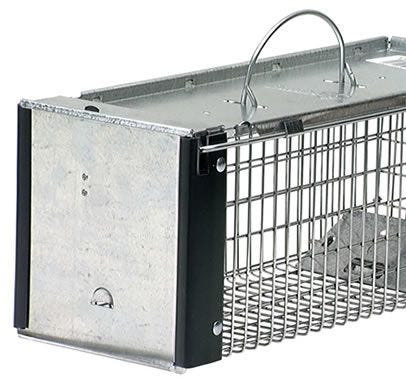
A live trap should be large enough so that the entire animal can fit inside the trap before it reaches the trigger plate. Depending on the size of the squirrel species in your area, select a trap that's extra small or small (15-25 inches in length). Most live squirrel traps come in 1 or 2-door variations:
| 1-Door |
|
| 2-Door |
|
For more information regarding these varieties, read about our Trap Types »
Shop Traps »2 Determine Trap Placement
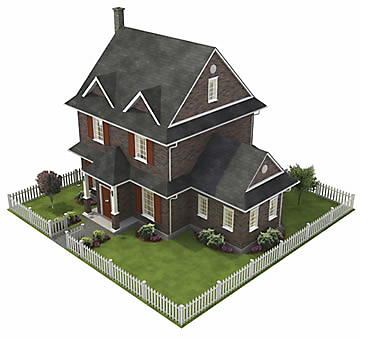
Place your trap on a flat surface along your squirrel's travel path. If you're not sure where that is, a good bet would be at the base of a tree or along a wall close to your damage area(s). Great trap locations include:
- along a wall in your attic, shed or crawlspace
- in front of an entryway
- at the base of a tree
- along a fence line nearby a frequented bird feeder
- a spot on your roof accessible by tree or power lines
TIP: Unlike many animals, squirrels tend to be more comfortable out in the open, rather than close to cover. Place your trap away from low-lying bushes or shrubs.
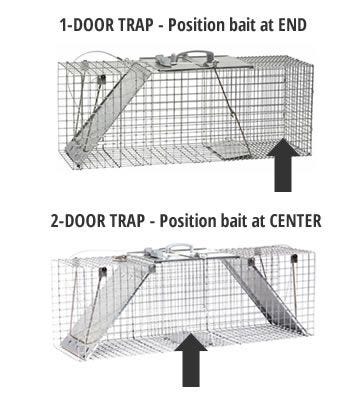
3 Select and Position Bait
Follow these critical guidelines when baiting your trap:
- Select a bait that squirrels can't steal: Spread peanut butter directly onto the trigger plate. When using a solid bait, make sure it's larger than the mesh openings of the trap - unshelled peanuts work well.
- Properly position bait: Position the bait so it forces the squirrel to engage the trigger (see diagram on the right).
For more baiting suggestions and expert tips, see How To: Squirrel Baits »
4 Set Your Trap
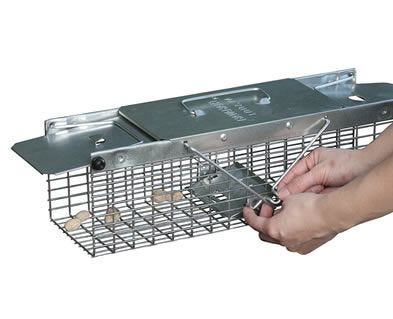
Carefully set your trap door(s) open by following its unique step-by-step setting instructions. Havahart® offers video instructions for each of its traps, which you can find on the individual product pages, or Havahart®'s YouTube page.
If you are using an Easy Set® trap, set it by simply pulling back on the Easy Set® lever.
Shop all Havahart® squirrel traps »
5 Check on Your Trap Often
It is inhumane to leave an animal trapped for an elongated period of time, because it can quickly grow hungry, thirsty or anxious. Check your trap frequently so your squirrel is not trapped longer than necessary.
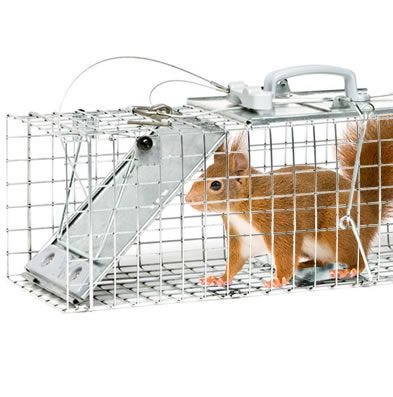
6 You've Caught a Squirrel!
- Wear gloves, and hold the trap by its handle to avoid contact with the squirrel. A squirrel bite may lead to injury or disease.
- If local laws permit, relocate the squirrel at least 10 miles away from your home.
- After releasing a squirrel, disinfect the trap to prevent the spreading of disease.

7 Keep Squirrels Out
Once you've removed your squirrel(s), keep them out by taking some important preventative steps:
- Reduce attractants: clean up fallen birdseed, nuts, berries, etc.; remove garbage; replace birdseed with a type squirrels dislike.
- Limit accessibility: trim tree branches within 10 feet of your home or feeders; cover nearby power lines with plastic tubing; install a chimney cap; repair broken vents/screens and holes in your home's exterior.
- Apply squirrel repellents: regularly apply squirrel repellents that contain capsaicin to repel squirrels by taste; frighten squirrels away with an electronic repellent.
Expert Tips
- Learn about the laws in your area before trapping and relocating a squirrel.
- The best time of year to trap a squirrel is either in late spring or early winter. During these times you have the best chance of preventing squirrels from breeding in your home, and you’re least likely to separate a mother from her dependent young.
- When trapping a squirrel outdoors, anchor your trap or place a heavy object on the top of the trap to prevent another animal from tipping it over and stealing the bait.
- Before attempting to catch a squirrel inside, confine your squirrel to one room or area by closing off all doors, small holes and cracks that may lead to other parts of the house.
- Disinfect your trap after each use with a bleach solution: mix 1 part bleach with 9 parts of water, apply the solution, and wait 20 minutes before wiping down the trap.
- The best way to get rid of squirrels is by adopting an integrated control plan that includes the use of repellents, traps and electronics. Havahart® has many solutions to keep squirrels away.
